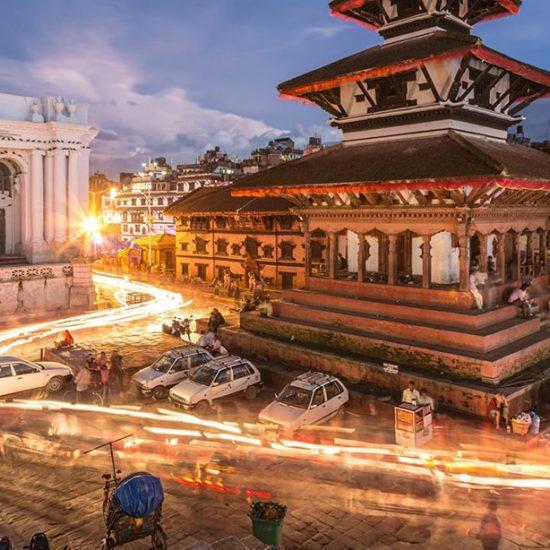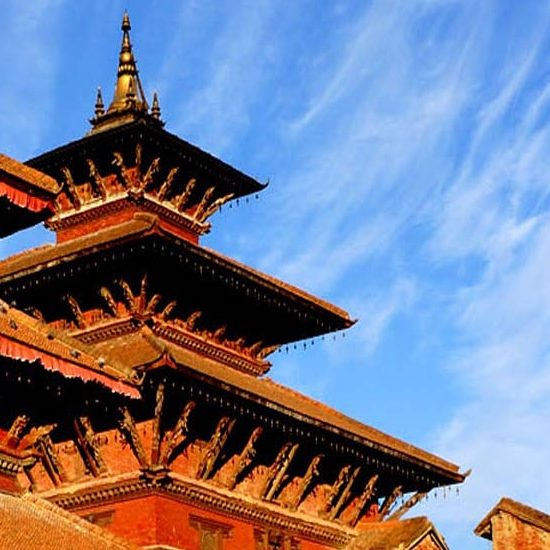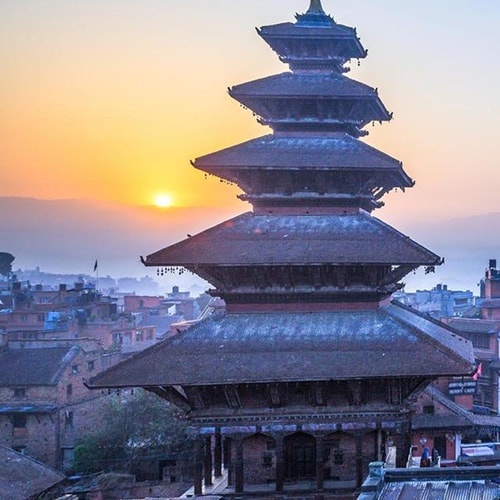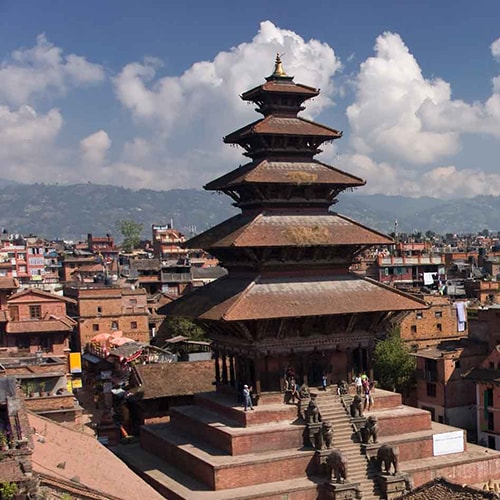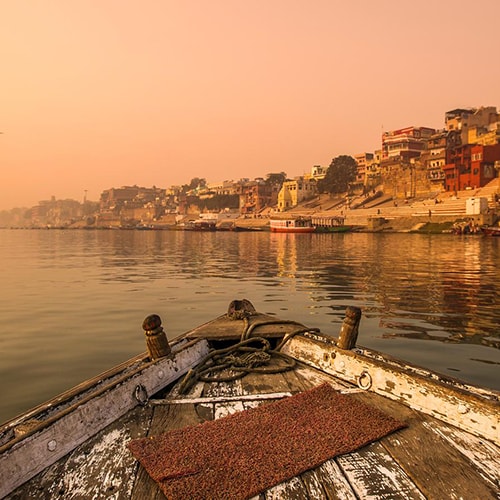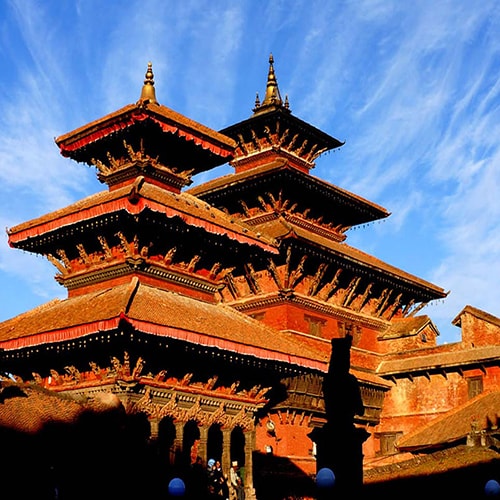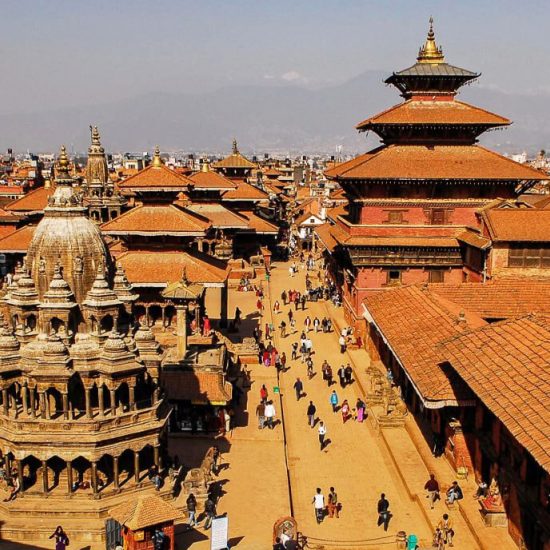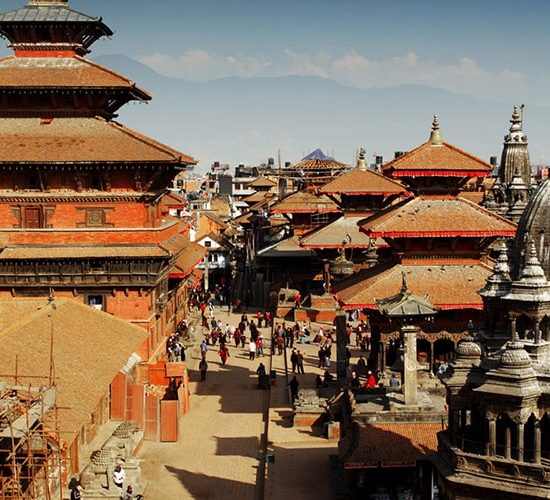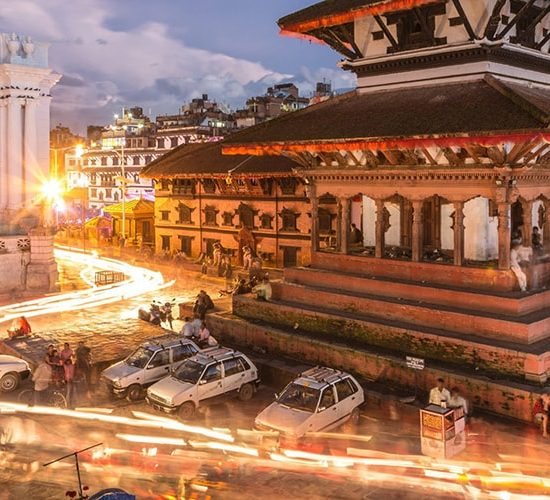Kathmandu is one of Nepal’s most sacred and ideal pilgrimages, the convergence of many Asian religions. The first attraction is the world’s largest Boudha Nath Tower with four eyes in four directions. The sacred Hindu Pashupatinath temple was built in 1696. The oldest and most important Hindu temple in Nepal. The Durbar Palace complex includes Hanumandhoka Palace, Kumari Char, Taleju Temple is a modern and attractive building.
If you have the opportunity to visit Nepal peacefully, you shouldn’t miss the visit to the beautiful and ancient city of Kathmandu. It’s the economic, political and social center of Nepal.
With its natural attractions and modern infrastructure, Kathmandu is a great getaway for travelers in Nepal.
Table of Contents
1. Understand
1.1 Etiquette
- Buddhist Sites Always walk clockwise around Buddhist stupas (bell-shaped religious structures), chörtens (Tibetan-style stupas) and mani (stone carved with a Tibetan Buddhist chant) walls.
- Head Wobble A sideways tilt or wobble of the head conveys agreement in Nepal, not a ‘no’.
- Greetings Nepalis rarely shake hands – the namaste greeting (placing your palms together in a prayer position) is a better choice.
- Respect When giving or receiving money, use your right hand and touch your right elbow with your left hand, as a gesture of respect.
- No shoes Always remove your shoes before you enter a private house or monastery.
- Dining Don’t use your left hand for eating or passing food to others as this hand is used for personal ablutions. Wash your hands and mouth before dining.
1.2 History
The history of Kathmandu is really a history of the Newars, the main inhabitants of the Kathmandu Valley. While the documented history of the valley goes back to the Kiratis, around the 7th century BC, the foundation of Kathmandu itself dates from the 12th century AD, during the time of the Malla dynasty.
The original settlements of Yambu and Yangala, at the confluence of the Bagmati and Vishnumati Rivers in what is now the southern half of the old town, grew up around the trade route to Tibet. Traders and pilgrims stayed at rest houses such as the now destroyed Kasthamandap, which lent its name to the city.
Originally known as Kantipur, the city flourished during the Malla era, and the bulk of its superb temples, buildings and other monuments date from this time. Initially, Kathmandu was an independent city within the valley, but in the 14th century the valley was united under the rule of the Malla king of Bhaktapur. The 15th century saw division once more, this time into three independent kingdoms: Kathmandu, Patan and Bhaktapur. Rivalry between the three city-states led to a series of wars that left each state weakened and vulnerable to the 1768 invasion of the valley by Prithvi Narayan Shah.
The ensuing Shah dynasty unified Nepal and made the expanded city of Kathmandu its new capital – a position the city has held ever since. In 1934 a massive earthquake reshaped parts of Kathmandu, and the reconstruction created a network of modern boulevards such as New Rd.
Kathmandu escaped the worst of the Maoist uprising in the 1990s, though the city was frequently crippled by demonstrations and strikes. Tens of thousands of Nepalis flooded into the rapidly expanding city to escape the political violence, and the city infrastructure is still struggling to cope even a decade after the end of the conflict.
On 25 April 2015, history repeated itself as another massive earthquake shook the Kathmandu Valley. Several of Kathmandu’s most famous monuments were reduced to rubble and the city swelled with rural refugees whose homes had been destroyed. While life is slowly returning to normal in the Nepali capital after the disaster, the repercussions of the earthquake are likely to be felt for generations.
1.3 Basic stats
Area
49 sq km
Area Code
01
Population
1.3 millionElevation
1337m
Time
Nepal Standard Time (GMT/UTC plus 5¾ hours)
1.4 Further reading
Kumari Devi
Not only does Nepal have hundreds of gods, goddesses, deities, bodhisattvas, Buddhas, avatars (incarnations of deities) and manifestations – which are worshipped and revered as statues, images, paintings and symbols – but it also has a real, living goddess. The Kumari Devi is a young girl who lives in the building known as the Kumari Bahal, right beside Kathmandu’s Durbar Sq.
The practice of having a living goddess probably came about during the reign of the last of the Malla kings of Kathmandu, and although there are actually a number of living goddesses around the Kathmandu Valley, the Kumari Devi of Kathmandu is the most important. The Kumari is selected from a particular caste of Newari gold- and silversmiths. Customarily, she is somewhere between four years old and puberty, and must meet 32 strict physical requirements ranging from the colour of her eyes and shape of her teeth to the sound of her voice. Her horoscope must also be appropriate, of course. The most recent Kumari, three-year-old Trishna Shakya, took on her role in September 2017.
Once suitable candidates have been found they are gathered together in a darkened room where terrifying noises are made, while men dance by in horrific masks and 108 gruesome buffalo heads are on display. These goings-on are presumed unlikely to frighten an incarnation of Durga, so the young girl who remains calm and collected throughout this ordeal is clearly the new Kumari. In a process similar to the selection of the Dalai Lama, as a final test the Kumari then chooses items of clothing and decoration worn by her predecessor.
Once chosen as the Kumari Devi, the young girl moves into the Kumari Bahal with her family and makes only a half-dozen ceremonial forays into the outside world each year, mainly during the September Indra Jatra festival, when she travels through the city on a huge temple chariot.
The Kumari’s reign ends with her first period, or any serious accidental loss of blood. Once this first sign of puberty is reached she reverts to the status of a normal mortal, and the search must start for a new Kumari. On retirement the old Kumari is paid a handsome dowry but readjusting to normal life can be hard. It is said that marrying an ex-Kumari is unlucky, perhaps because taking on a spoilt ex-goddess is likely to be too much hard work!
Boris Lissanevitch
Boris Lissanevitch is known as the godfather of tourism in Nepal. He was a fascinating figure, a white Russian émigré who fled the Bolshevik Revolution and worked at various times as a ballet dancer, chef, tiger hunter, fighter pilot, Shanghai club owner and trapeze artist. A friend of Ingrid Bergman, he acted in a film with Jean-Paul Belmondo.
Boris was running the Club 300 in Calcutta when he first met King Tribhuvan in 1944 (some even whisper that Boris helped pass secret messages between the king and Nehru, helping overthrow the Rana regime). Tribhuvan later invited him to Nepal to open Nepal’s first hotel, the Royal, in a former royal palace (now the Electoral Commission Building). He brought the first tour group to the kingdom and hosted early mountaineering groups who would camp on the front lawn. The hotel and its famous Chimney Restaurant closed in the 1970s but would later morph into the Yak & Yeti Hotel, where to this day you can sip on Russian borscht at the Chimney Restaurant.
2. On the ground
2.1 Sights
Erotic Art (or How They Did it in Ancient Times)
The most eye-catching decorations on Nepali temples are the erotic scenes, often quite explicit, that decorate the tunala (roof struts). These scenes are rarely the central carving on the strut; they’re usually the smaller carving at the bottom of the strut, like a footnote to the larger image, and in a crude, even cartoonlike style.
The purpose of the images is unclear. Are they simply a celebration of an important part of the life cycle? Are they a more explicit reference to Shiva’s and Parvati’s creative roles than the enigmatic lingams (phallic symbols) and yonis (female sexual symbols) scattered around so many temples? Or are they supposed to play some sort of protective role for the temple? It’s popularly rumoured that the goddess of lightning is a shy virgin who wouldn’t dream of striking a temple with such goings-on, although that’s probably more a tour-guide tale than anything else.
Whatever the reason for their existence, these Tantric elements can be found on temples throughout the valley. Some temples reveal just the odd sly image, while others are plastered with the 16th-century equivalent of hard-core pornography, ranging from impressively athletic acts of intercourse to medieval ménages à trois, scenes of oral or anal intercourse or couplings with demons or animals.
The temples you may want to avoid showing your kids include Kathmandu’s Jagannath Temple, the damaged Basantapur (Kathmandu) Tower and Ram Chandra Temple; Patan’s Jagannarayan Temple; and Bhaktapur’s Erotic Elephants and Pashupatinath Temples.
Quirky Kathmandu
Kathmandu has more than its fair share of quirk and, as with most places in the subcontinent, a 10-minute walk in any direction will throw up numerous curiosities.
The corridors of the Natural History Museum are full of bizarre moth-eaten animals and jars that lie somewhere between a school science experiment and The Texas Chainsaw Massacre. The 20ft python skin and nine-month-old baby rhino in a jar are guaranteed to give you nightmares. The other exhibits are a bit slapdash, including the line of stuffed birds nailed carelessly to a bit of wood to indicate their distribution, or the big pile of elephant dung deposited randomly in the front corner.
The nearby National Museum also houses more than its fair share of weirdness, including the skin of a two-headed calf, a creepy doll collection and a portrait of King Prithvi Narayan Shah giving everyone the finger (apparently symbolising the unity of the nation…).
Once it reopens following earthquake repairs, the Tribhuvan Museum in Hanuman Dhoka should still be the place to see such quirky gems of royal paraphernalia as the king’s personal parachuting uniform, his film projector and his walking stick with a spring-loaded sword inside – very ‘007’.
Kathmandu’s Kaiser Library is definitely worth a visit, partly for its remarkable collection of antique travel books but also for the main reading room, which has antique globes, a stuffed tiger and suits of armour that you expect to spring to life at any moment.
Compared to all this funkiness, Kathmandu’s old town is pretty docile. Look for the antique fire engines hidden behind a grille just west of the junction of New Rd and Sukra Path.
If you get a toothache during your trip, be sure to visit the old town’s toothache god across from Sikha Narayan Temple – the god is represented by a tiny image in a raggedy old stump of wood covered with hundreds of nails and coins.
Walking Tours
Kathmandu’s backstreets are dense with beautiful temples, shrines and sculptures, especially in the crowded maze of streets and courtyards in the area north of Durbar Sq, and exploring these half-hidden sights is a real highlight.
The old town is bursting with traditional markets, temples, tole (streets), bahal (Buddhist monastery courtyards), bahil (residential courtyards) and chowk (intersections), which remain the focus of traditional Nepali life. You only really appreciate Kathmandu’s museum-like quality when you come across a 1000-year-old statue – something that would be a prized possession in many Western museums – being used as a plaything or a washing line in some communal courtyard.
For the best markets and most important temples explore with our backstreets walking tour between Thamel and Durbar Sq. For fewer spectacular sights but where the everyday life of city dwellers goes on and tourists are few and far between, follow our walking tour south of Durbar Sq.
If walking tours leave you wanting more, pick up Annick Holle’s book Kathmandu the Hidden City or John Child’s Streets of Silver, Streets of Gold, both of which detail dozens of backstreet courtyards across town.
Durbar Square
Kathmandu’s Durbar Square was where the city’s kings were once crowned and legitimised, and from where they ruled (‘durbar’ means palace). Tragically, parts of the square were seriously damaged during the 2015 earthquake. As the first tremor hit, palace
2.2 Activities
The swimming pools at the Annapurna, Shanker and Radisson hotels are open to non-guests for around Rs 1000. The Hyatt charges Rs 1250 for its pool, or Rs 1700 for its pool, gym, tennis court and sauna. Add tax to all these.
For golf near the capital, head to Gokarna Forest Resort Golf Course.
Adventure Sports
An increasing number of adventure operators offer mountain biking, climbing, canyoning, rafting and kayaking trips from Kathmandu.
Mountain Flight
A popular activity from Kathmandu is to take an early-morning scenic mountain flight (US$199) along the spine of the Himalaya for close-up views of Mt Everest and other peaks from a distance of just 9.3km. Major airlines like Buddha Air and Yeti Airlines offer the hour-long flights and each passenger on the six- to 30-seat turbo props is guaranteed a window seat.
The quality of the views depends on weather conditions. If the flight is cancelled due to bad weather, airlines offer a full refund or a seat on a later flight. In 2011 a Buddha Air mountain flight crashed outside Kathmandu, killing 19 people.
Hash House Harriers
The Nepal branch of these ‘drinkers with a running problem’ meets for a run every Saturday afternoon. Check www.aponarch.com/hhhh for details.
2.3 Sleeping
Kathmandu has a huge range of places to stay, from luxurious international-style hotels to cheap and cheerful lodges. Most budget and some midrange options are found in the bustling Thamel district. Midrange and top-end places are widely scattered around Kathmandu, some quite a way from the centre.
Thamel
For budget and midrange places, the tourist ghetto of Thamel is the main locale. It’s a convenient area to stay for a short time, especially to meet fellow travellers or indulge in some last-minute shopping, but you are likely to tire of the noise and congestion in a couple of days.
In an attempt to establish some order in this sprawling chaos, we have somewhat arbitrarily divided the Greater Thamel area as follows: central Thamel, around the two central intersections; Paknajol, to the north; Bhagwan Bahal, to the northeast; Jyatha, to the southeast; and Chhetrapati, to the southwest.
Several top-end international chains are building properties on the edge of Thamel, including Aloft Kathmandu (2019) in the new 15-storey Chhaya Center building (www.chhayacenter.com) and a nearby Sheraton (in June 2019).
Central Thamel
The heart of the action; you can’t get a more convenient location than this.
Paknajol (Northern Thamel)
This area lies to the northwest of central Thamel and can be reached by continuing north from the Kathmandu Guest House, or by approaching from Lekhnath Marg to the north.
Not far from the steep Paknajol intersection with Lekhnath Marg (northwest of Thamel) are half a dozen pleasant guesthouses grouped together in a district known as Sorakhutte. They’re away from traffic, a short walk from Thamel (but it could be a million miles), and they have fine views across the valley towards Balaju and Swayambhunath.
Bhagwan Bahal (Northeastern Thamel)
This area is quieter than central Thamel, offers more space and is closer to transport options and access to the rest of the city. There are several huge new five-star developments under construction here.
Jyatha (Southeastern Thamel)
The neighbourhood southeast of Thamel is traditionally known as Jyatha. The southern section has evolved into a popular area with Chinese tourists.
Turn east a short way down Jyatha Rd, and a couple of twists and turns will bring you to a neat little cluster of modern guesthouses, whose central but quiet location feels a million miles from the Thamel hustle.
Chhetrapati (Southwest Thamel)
This area is named after the important five-way intersection (notable by its distinctive bandstand) to the southwest of Thamel. The further you get from Thamel, the more traditional the surroundings become.
Freak Street (Jhochhen) & Durbar Square
Although Freak St’s glory days have passed, a few determined budget restaurants and lodges have clung on. Staying here offers three pluses – you won’t find rooms much cheaper, there are fewer crowds and you’re right in the heart of the fascinating old city. On the downside, the pickings are slimmer and the lodges are generally grungier than in Thamel.
Freak Street – The End of the Road
Running south from Basantapur Sq, Freak St dates from the overland days of the late 1960s and early 1970s, when it was one of the great gathering places on ‘the road east’. In its hippie prime, this was the place for cheap hotels (Rs 3 a room!), colourful restaurants, hash and ‘pie’ (pastry) shops, the sounds of Jimi and Janis blasting from eight-track players and, of course, the weird and wonderful foreign ‘freaks’ who gave the street its name. Along with Bodhnath and Swayambhunath, Freak St was a magnet for those in search of spiritual enlightenment, cheap dope and a place where the normal boundaries no longer applied.
Times change and Freak St (better known these days by its real name, Jhochhen) is today only a pale shadow of its former funky self. While there are still cheap hotels and restaurants, it’s the Thamel area in the north of the city that is the main gathering place for a new generation of travellers. However, for those people who find Thamel too slick and commercialised, Freak St retains a faint echo of those mellower days.
Central Kathmandu
These hotels are within walking distance of Durbar Marg and the Thamel area, and fall into the top-end price range.
Lazimpat
North of central Kathmandu is the Lazimpat embassy area, popular with NGO staff, repeat visitors and business people.
Elsewhere
The edges of the city offer a quietish escape if you don’t mind a drive into the city each day. The eastern Swayambhunath region offers a distinctly Tibetan flavour.
Outside the City
Some travellers base themselves further afield, outside Kathmandu in Patan or Bodhnath, to escape the increasingly unpleasant traffic, pollution and commercialism of Thamel, and this isn’t a bad idea. For something quieter still, an increasing number of midrange and top-end resorts around the Kathmandu Valley offer a peaceful rural atmosphere less than an hour from the centre of Kathmandu.
Discounts
It’s always worth asking for a discount, particularly during low season when most places offer discounts of between 20% and 40%. Midrange and top-end places add on an extra 23% tax, but most budget places offer inclusive rates. If you email a reservation in advance many places offer a free airport pick-up.
Room Varieties
It’s difficult to recommend hotels in the budget and midrange brackets, as rooms in each hotel can vary widely. Many of these hotels have multiple wings and, while some rooms may be very gloomy and run-down, others (generally the upper floors) might be bright and pleasant. In general, roadside rooms are brighter but noisier than interior rooms, and top-floor rooms are the best as you stand a chance of getting a view and have easy access to the roof garden.
Budget places generally don’t have heating so in winter, you’ll want the warmer south-facing rooms and garden access, as it’s always pleasant to sit outside during the cool, but sunny, autumn and winter days.
Quite a few hotels bridge the budget and midrange categories by having a range of room standards – these places have been grouped according to their lowest price.
2.4 Eating
Kathmandu has an astounding array of restaurants. Indeed, with the possible exception of the canteen at the UN building, there are few places where you can have the choice of Indian, Chinese, Japanese, Mexican, Korean, Middle Eastern, Italian or Irish cuisines, all within a five-minute walk. After weeks trekking in the mountains, Kathmandu feels like a culinary paradise.
Nepali & Newari Restaurants
A growing number of restaurants around town specialise in Nepali (mostly Newari) food. Several are in converted Rana-era palaces that offer a set meal, either veg or nonveg, and you dine on cushions at low tables. All offer a cultural show that consists of musicians and dancers performing ‘traditional’ song and dance routines. The whole thing is a bit touristy, but it’s a classy night out nonetheless. At most places it’s a good idea to make a reservation during the high season.
The food stretches to half a dozen courses that generally include a starter of momos and such main dishes as alu tareko (fried potato with cumin and tumeric), bandhel (boar), kukhura ko ledo (chicken in gravy), chicken sekuwa (barbecued or smoked meat), alu tama kho jhol (bamboo shoot stew) and gundruk (sour soup with dried greens), finished off with shikarni (sweet yoghurt with dried fruit and cinnamon) and masala tea. Look out also for kwati, a soup consisting of a dozen types of sprouted beans that is prepared during Newari festivals.
Thamel
The junction outside the Kathmandu Guest House is the epicentre of Thamel dining and you’ll find dozens of excellent restaurants within a minute’s walk in either direction. You should make dinner reservations at most of these places in October’s high season.
Freak Street (Jhochhen) & Durbar Square
Freak St has a small number of budget restaurants where you can find simple food at lower prices than Thamel. Even if you’re staying in other areas of the city, you might need a place for lunch if you’re sightseeing around Durbar Sq.
Central Kathmandu
The restaurants in the Kantipath and Durbar Marg areas are generally more expensive than around Thamel, but the quality is higher and there are are several worthwhile splurges.
Elsewhere
Dwarika’s has a candlelit Friday-night poolside barbecue and dance show (US$30) that makes for a great splurge.
There are also several excellent midrange and top-end dining options in Patan, a short taxi ride away.
Self-Catering
For trekking food such as noodles, nuts, dried fruit and cheese, there are several well-stocked supermarkets grouped around central Thamel Chowk. For cheaper supermarkets try the various branches of Bluebird Mart, one of which is just east of Durbar Sq; Big Mart in Lazimpat, near the Radisson Hotel; and Bhat Bhateni Supermarket, south of the Chinese embassy.
Costs
Thamel’s restaurant scene has been sliding upmarket for a few years now, with most places now charging US$5 to US$7 per main course, plus 24% tax. A bottle of beer will double your bill in most places. Finding a budget meal is still possible but it involves some hunting.
Many restaurants in Kathmandu try to serve something from everywhere – pizzas, momos, Indian curries, a bit of Thai here, some Mexican tacos there. Predictably, the ones that specialise generally serve the finest food.
Delivery
If you can’t face battling Kathmandu’s traffic, Foodmandu (www.foodmandu.com) is an online service and app that will bring you food from 170 restaurants in Kathmandu. Delivery cost depends on the distance, but is generally less than Rs 100; orders are taken until 8.30pm.
2.5 Drinking and nightlife
There are bars scattered around Thamel, all within a short walk of each other. Just poke your nose in to see which has the crowd and style that appeals. Many have live bands, though the playlists can get monotonously familiar. Most bars in Thamel close by 11pm, or midnight on Fridays and Saturdays.
Costs
A beer costs between Rs 450 and Rs 550, plus 23% tax. Most places have a happy hour between 5pm and 8pm, with two-for-one cocktails, and a modest beer discount.
Dangers & Annoyances
Be wary of Thamel’s sleazy ‘dance bars’ or ‘shower dance’ bars. At first glance many seem quite tame, but many are fronts for the prostitution of trafficked women.
2.6 Entertainment
Nepal is an early-to-bed country and even in Kathmandu you’ll find few people on the streets after 10pm, especially when the capital’s political situation is tense.
Major sporting events such as English Premier League football and the Formula 1 grand prix are televised in all the major bars.
Casinos
Kathmandu’s casinos are attached to most of the five-star hotels and are open 24 hours, though they are sometimes closed by the government due to disputes over unpaid taxes. You can play in either Indian rupees or US dollars, and winnings (in the same currency) can be taken out of the country when you leave. The main games offered are roulette and blackjack. Most clients are Indian; Nepalis are officially forbidden from entering.
Music & Dance
Duelling cover bands compete for aural supremacy at various Thamel restaurants on Friday and Saturday nights in the high season – just follow the sounds of Bryan Adams and Coldplay covers.
There are a few cultural performances in the restaurants of the top-end hotels, which generally involve local youths wearing a variety of dress over their jeans and performing traditional dances from Nepal’s various ethnic groups, accompanied by a live band that includes a tabla, harmonium and singer.
Cinemas
Sadly, the video cafes made famous by the title of Pico Iyer’s book Video Night in Kathmandu have disappeared, replaced by fake DVD stores.
2.7 Shopping
Kathmandu offers the best shopping in the country. Everything that is turned out in the various centres around the valley can be found here. The recent pedestrianisation of parts of Thamel has made it a much more pleasant place to shop; hopefully the traffic-free status will be maintained. Other streets still suffer from chaotic traffic; dive into a side street or garden haven when stress levels start to rise.
The Essential Thamel Shopping Guide
From Kashmiri carpets to trekking poles and yak-milk soap, Thamel offers the best collection of shops in the country. Bring an extra bag (or buy one here!) and stock up early on Christmas presents.
Spices Plenty of shops and supermarkets in Thamel sell small packets of spices, from momo mixes to chai spices, or head to Asan Tole, where the locals buy their freshly ground masalas.
Embroidery Sewing machines around Thamel whirr away late into the night adding logos and Tibetan symbols to jackets, hats and T-shirts. Trekkers can commission badges and T-shirts commemorating their successful trek or even get a business logo made.
Jewellery Kathmandu is a great place for jewellery, particularly silver. Buy it ready-made, ask the jeweller to create a design for you or bring in something you would like copied. The price of silver is quoted per tola (11.7g) in the daily newspaper.
Puppets Puppets make good gifts for children and are made in Bhaktapur as well as other centres. They’re often of multi-armed deities clutching little wooden weapons in each hand. The puppet heads may be made of easily broken clay or more durable papier mâché.
Pashminas A shawl or scarf made from fine pashmina (the underhair of a mountain goat) is a popular buy. The cost of a shawl depends on the percentage of pashmina in the mix and from which part of the goat’s body the hair originated, starting from the cheapest back wool and rising through the belly and chest to neck hair, which is about five times more expensive than back hair. The cheapest shawls are a 70/30% cotton/pashmina blend, silk-pashmina blends cost around 30% more and pure pashmina shawls range from around US$50 to US$275 for a top-end ring shawl (named because they are fine enough to be pulled through a finger ring; also known as a water shawl).
Tea Ilam, Ontu, Kanyan and Mai Valley teas are the best Nepali teas, from the east of the country near Darjeeling. Expect to pay anything from Rs 600 (in Ilam) to Rs 3000 (in Thamel) per kilogram for good Ilam tea. The excellently named ‘super fine tipi golden flower orange pekoe’ tea is about as good as it gets. Connoisseurs choose the first (March) or second (May) flush, rather than the substandard monsoon flush. Lemon tea flavoured with lemongrass is another favourite, as is pre-spiced masala tea.
Clothes There are lots of funky wool hats, felt bags, embroidered T-shirts (our favourite has ‘Same Same…’ on the front and ‘…But Different’ on the back!), jumpers etc, particularly on the twisting road known as Saatghumti. Always try clothes on before handing over the cash. Impossibly cute baby-sized North Face fleeces and down jackets are hard to pass by.
Prayer flags The best place to buy is the street in front of the Kathesimbhu Stupa south of Thamel. Choose between cheaper polyester and better-quality cotton flags and remember, this is your karma that we are talking about.
What to Buy
Thamel has some excellent trekking gear for sale, but don’t think that you are necessarily getting the genuine article. Most of the ‘Columbia’ fleeces and ‘North Face’ jackets are Chinese knock-offs or made locally but with imported fleece and Gore-Tex.
Kathmandu has dozens of excellent bookshops with a great selection of Himalaya titles, including books that are not usually available outside the country. Many dealers will buy back books for 50% of what you paid.
An endless supply of curios, art pieces and plain old junk is churned out for the tourist trade. Most does not come from Tibet but from the local Tamang community. Prayer flags and prayer wheels are a popular buy in Durbar Sq, Bodhnath and Swayambhunath, but be prepared to bargain.
In general you’ll often find a better choice of crafts, or more unusual items, in the centres that produce the items – Jawalakhel (southern Patan) for Tibetan carpets, Patan for cast-metal statues, Bhaktapur for woodcarvings, and Thimi for masks. Head over to Patan to find well-stocked fair-trade shops.
Remember that antiques (over 100 years old) cannot be taken out of the country. Get a receipt and a description of any major purchase from the shop where you bought it. If in doubt get your item verified at the Department of Archaeology.
2.8 Orientation
The most interesting part of Kathmandu is the crowded backstreets of the rectangular-shaped old town. This is bordered to the east by the sprawling modern new town and to the north by the main tourist and backpacker district of Thamel (pronounced tha-mel). With over 2500 tourist-related companies jammed into half a dozen narrow streets, Thamel boasts a collection of hotels, restaurants, trekking agencies, bakeries and shops that is rivalled only by Bangkok’s Khao San Rd. Thamel is 15 to 20 minutes’ walk north from Durbar Sq.
East of Thamel is Durbar Marg, a wide street flanked by airline offices, restaurants and expensive hotels. Further north are the embassy and NGO districts of Lazimpat and Maharajganj. To the south of town is Patan, a historically distinct city, which has now partially merged with Kathmandu’s southern sprawl. Both Kathmandu and Patan are encircled by the Ring Rd.
In old Kathmandu, streets are only named after their district, or tole.The names of these districts, squares and other landmarks (perhaps a monastery or temple) form the closest thing to an address. For example, the address for everyone living within a 100m radius of Thahiti Tole is Thahiti Tole. ‘Thamel’ is now used to describe a sprawling area with at least a dozen roads and several hundred hotels and restaurants.
Given this anarchic approach it is amazing that any mail gets delivered – it does, but slowly. If you’re trying to find a particular house, shop or business, make sure you get detailed directions.
3. Organize your time
3.1 Itineraries
Two Days
Start off the day with a walking tour south from Thamel to Durbar Sq. Grab lunch overlooking Basantapur Sq or in nearby Freak St and then spend the afternoon soaking up the architectural grandeur of Durbar Square. Finish the day with a cold beer and dinner in the Thamel area.
Next day head out to Swayambhunath Stupa in the morning and spend the afternoon shopping in Thamel. For your final meal, splurge at one of the blowout Newari restaurants such as Bhojan Griha or Thamel House.
Four Days
If you have an extra couple of days, take a short taxi ride out to Patan for a full day exploring its Durbar Sq and Patan Museum (the best in the country); take a fascinating backstreet walking tour. For dinner, dine in one of Jhamsikhel’s excellent restaurants.
On day four take a taxi to Pashupatinath Temple and then take the short walk out to Bodhnath Stupa to soak up some Tibetan culture as the pilgrims gather at dusk.
One Week
With a week up your sleeve, you can spend a day (and preferably a night) at Bhaktapur. When stress levels build, fit in some quiet time at the delightful Garden of Dreams.
Seven days gives you the chance to gorge on Thai (Yin Yang), Indian (Third Eye), Korean (Hankook Sarang), steak (K-Too), felafel (Or2k) and maybe even some Nepali food! Don’t get us started on lunch…
3.2 When to go and weather
Oct–Dec Fine mountain views and warm days until December, with high-season crowds.
Mar–May March brings the Seto Machhendranath festival. Days can be hot in May.
Jun–Sep Hot days and frequent monsoon showers, but also the spectacular Indra Jatra festival.
4. Planning tools
4.1 Kathmandu is known for
Architecture
Statues that would be in museums anywhere else dot the streets of Kathmandu, competing for space with myriad temples, shrines and civic squares.
Hanuman Dhoka The former royal palace is a glorious fusion of Newari and European architectural elements, despite being under post-earthquake renovation.
Swayambhunath Stupa Rising above Kathmandu like a gilded exclamation mark, the so-called ‘Monkey Temple’ is a Buddhist treasure.
Seto Machhendranath Temple Hindu and Buddhist motifs mingle at this fascinating temple in the historic old city.
Kumari Bahal Admire the intricately carved balconies and window frames at the home of Kathmandu’s living goddess.
Divine Culture
The lavish ornamentation of Kathmandu’s temples and shrines is not just decoration. Every symbol and motif has a profound spiritual significance, which may only be revealed during one of the city’s frenetic festivals.
Kumari Bahal Kathmandu’s secretive living goddess appears daily in the window of her palace.
Seto (White) Bhairab During Indra Jatra, rice beer flows from the mouth of this enormous mask of Bhairab.
Taleju Temple The largest temple in Durbar Sq is closed to all, except for a single day during the Dasain festival.
Narayanhiti Palace Museum The last home of the now-deposed Nepali royal family – once worshiped as incarnations of the Hindu god Vishnu.
Peace and Quiet
Downtown Kathmandu can be crowded and chaotic, so find space to reflect in these calmer quarters.
Garden of Dreams The fanciful project of a Rana playboy, these formal gardens are Thamel’s quietest corner.
Kathesimbhu Stupa A 17th-century copy of Swayambhunath, set in a calm, statue-studded courtyard.
National Museum With so much history in the streets, many overlook the quietly interesting state museum.
Kathmandu Guest House Escape the Thamel mayhem in this peaceful garden restaurant and bar.
Food
Kathmandu is Nepal’s culinary capital, and travellers and trekkers can feast on pretty much every cuisine under the sun, from Tibetan momos (dumplings) and Newari curries to pizzas and open-air barbecues.
Bhojan Griha Dinner takes the form of a royal banquet at this nostalgic Newari restaurant.
Fire & Ice Pizzeria Kathmandu’s favourite pizzeria keeps trekkers drooling with its imported Italian toppings.
Yangling Tibetan Restaurant You get no frills, but delicious momos at this low-key, family-run Tibetan food stop.
Kaiser Cafe A serene setting in the Garden of Dreams draws diners to this romantic Viennese cafe.
4.2 Money and costs
Currency
Nepali rupee (Rs)
Daily Costs
- Budget: Less than US$50
- Budget hotel room: US$15–30
- Momos at a Tibetan cafe: US$2
- Taxi ride across Kathmandu: US$2–5
- Midrange: US$50–150
- Midrange hotel: US$30–100
- Upscale restaurant meal: US$7–10
- Renting a motorcycle for a day: US$10–20
- Top End: More than US$150
- Top end hotel room: US$100–250
- Hiring a car and driver for a day of sightseeing: US$50
- Scenic mountain flight: US$200
Bargaining
Haggling is an integral part of most commercial transactions in Nepal, especially when dealing with souvenir shops, hotels and guides. Ideally, it should be an enjoyable social exchange, rather than a conflict of egos. A good deal is reached when both parties are happy; Rs 10 might make quite a difference to the seller, but to a foreign traveller it amounts to less than US$0.10.
Money
There are dozens of licensed moneychangers in Thamel. Their hours are longer than those of the banks (generally until 8pm or so) and rates are similar, perhaps even slightly higher if you don’t need a receipt.
There are ATMs everywhere in Thamel. Useful locations include beside Yin Yang Restaurant, Ganesh Man Singh Building and Roadhouse Cafe.
Himalayan Bank The most convenient bank for travellers in Thamel, this kiosk on Tridevi Marg changes cash without commission; on Saturdays or if its closed head to the main branch in the basement of the nearby Sanchaya Kosh Bhawan shopping centre. There’s a useful ATM next to the kiosk. It’s in front of the Three Goddesses Temples.
Standard Chartered Bank Well-located ATMs opposite the Third Eye restaurant and in the compound of the Kathmandu Guest House give up to Rs 35,000 per transaction but charge a Rs 500 commission. The main branch in Lazimpat charges Rs 200 per transaction for cash.
4.3 Travel with children
Because of the pollution and traffic, Kathmandu is not an easy place to travel with children. Kids will probably enjoy the zoo in nearby Patan and older kids will get a thrill from spotting the monkeys at Swayambhunath.
Away from the tourist areas, highchairs are virtually nonexistent, but finding non-spicy food that children will eat isn’t a problem.
Pilgrims Book House has a fine collection of kids’ books, including colouring books.
4.4 Gay and lesbian travelers
The Thamel area of central Kathmandu is so westernised that it functions almost as an international enclave. Nepalis are generally tolerant of gays and lesbians but it makes sense to be discreet outside of Thamel.
4.5 Travel with disabilities
Wheelchair facilities, ramps and lifts (and even pavements!) are virtually nonexistent throughout chaotic Kathmandu and getting around the packed, twisting streets in the old part of town can be a real challenge if you are in a wheelchair (and even if you are not). That said, it shouldn’t be too difficult to arrange a minivan and helper and visit major sights like Durbar Sq.
It is common for hotels to be multilevel, with most rooms on the upper floors. Many places – even midrange establishments – do not have lifts. Bathrooms equipped with grips and railings are not found anywhere, except perhaps in some of the top-end hotels.
4.6 Entry and exit formalities
Visa Extensions
Visa extensions of 30 to 60 days are fairly painless at the Central Immigration Office. You need to make your application online and upload a photo up to 15 days before arriving at the office, though there is currently a computer in the hall in case you forget. The process generally takes less than one hour. Extensions cost US$30 for a minimum 15 days, plus US$2 per additional day
4.7 Planning tips
Resources
Nepal Tourism Board (www.welcomenepal.com) Government site.
Visit Nepal (www.visitnepal.com) Comprehensive private website with detailed travel tips
Inside Himalayas (www.insidehimalayas.com) Online magazine and blog devoted to travel in Nepal.
kimkim (www.kimkim.com) Booking platform that has lots of good background articles on Nepal.
5. Practical information
5.1 Getting around
Bicycle
Cycling is a good way to explore parts of the Kathmandu Valley and many companies offer bike rentals and tours. You need to be selective about your routes to avoid heavy traffic.
Mountain bikes cost from around Rs 800 per day for simple models. For longer trips around the valley, the major mountain-bike companies such as Dawn Till Dusk and Nepal Mountain Bike Tours hire out high-quality bikes with front suspension and disc brakes for around US$10 to US$15 per day.
If you want to make an early start, most places are happy to give you the bike the evening before. For all bikes, negotiate discounts for rentals of more than a day. You should get a helmet, a lock and a repair kit. Check the brakes before committing and be certain to lock the bike whenever you leave it.
Cycle-Rickshaw
Cycle-rickshaws cost around Rs 80 for short rides around Thamel or the old town, but you can expect to haggle hard. It’s essential to agree on a price before you start.
Motorcycle
There are a number of motorcycle-rental operators in Thamel. You will have to leave your passport as a deposit. For Rs 800 per day you’ll get a 150cc Indian-made Hero Honda or a Pulsar road bike, which is generally fine for road trips in the Kathmandu Valley.
Reputable rental companies will require you to have an International Driving Permit to ride a motorbike in Nepal. On the road, this regulation hasn’t been enforced for years, but recent reports suggest traffic police are targeting foreigners on this and other hitherto disregarded traffic violations in an attempt to raise funds. A traffic fine will set you back around Rs 1000.
Motorcycles can be great fun outside town, once you master the traffic. The main problem is getting out of Kathmandu, which can be a stressful, choking and dangerous experience. You will need a pair of goggles and some kind of face mask (available in most pharmacies).
Fuel currently costs Rs 100 per litre; you’ll only need a couple of litres for a day trip. Beyond the ring road petrol stations are few and far between.
Singh Motorbike Centre A reliable place for bike hire. New Indian-made Pulsar 200cc motorbikes (Rs 1500) are most commonly available, though you might find a cheaper Hero Honda (Rs 700) or an Enfield Bullet (Rs 3000).
Pheasant Transportation Service Down a side street off the central Thamel junction, this tiny office has somewhat elastic prices, with a Honda 150cc starting at Rs 800, a Pulsar 220cc around Rs 1200 and an Enfield Bullet 350cc costing Rs 2000.
Taxi
Taxis are quite reasonably priced, though few taxi drivers use the meters in these days of rising fuel prices. Shorter rides around town (including to the bus station) cost around Rs 200. Night-time rates (between 10pm and 6am) cost 50% more.
Most taxis are tiny Suzuki Marutis, which can just about fit two backpackers and their luggage.
The closest taxi stand to Thamel is on Tridevi Marg, close to the junction with Jyatha Rd. Taxis can be booked in advance on 01-4420987; at night call 01-4224374.
Approximate taxi fares from Thamel include the following:
- Bhaktapur Rs 700
- Bodhnath Rs 600
- Budhanilkantha Rs 700
- Changu Narayan Rs 1600
- Nagarkot Rs 3000
- Pashupatinath Rs 500
- Patan Rs 500
- Swayambhunath Rs 300
5.2 Flights and getting there
Medical Services
Dozens of pharmacies on the fringes of Thamel offer all the cheap antibiotics you can pronounce.
CIWEC Clinic Travel Medicine Center In operation since 1982 and has an international reputation for research into travellers’ medical problems. Staff are mostly foreigners and a doctor is on call round the clock. Credit cards are accepted and the centre is used to dealing with insurance claims.
CIWEC Dental Clinic US dentist on the top floor of the CIWEC Clinic.
Healthy Smiles UK-trained dentist, opposite the Hotel Ambassador, with a branch in Patan.
Nepal International Clinic Just south of the New Royal Palace, east of Thamel. It has an excellent reputation and is slightly cheaper than the CIWEC Clinic. Credit cards accepted.
NORVIC International Hospital Private Nepali hospital with a good reputation for cardiology.
Patan Hospital Perhaps the best hospital in the Kathmandu Valley.
5.3 Health
Dangers & Annoyances
Kathmandu is a fairly safe city, but what it lacks in dangers it more than makes up for in annoyances:
The combination of ancient vehicles, low-quality fuel and lack of emission controls makes the streets of Kathmandu particularly polluted, noisy and unpleasant.
Avoid the city’s seedy dance bars and street-corner hashish sellers – although variably enforced, the penalties for possession can be severe.
Traffic Problems
Pedestrians account for over 40% of all traffic fatalities in Nepal. Bear in mind the following:
Traffic rules exist, but are rarely followed or enforced; be especially careful when crossing streets or riding a bicycle.
Traffic is supposed to travel on the left side of the road, but many drivers simply choose the most convenient side, which can make walking in Kathmandu a deeply stressful experience.
Consider buying a face mask to filter out dust and emission particles, especially if you plan to ride a bicycle or motorcycle in Kathmandu. After a few days in the city you’re likely to feel the onset of a throat infection.
Post-earthquake repairs are ongoing and there is lots of rubble piled up in the streets, creating additional hazards for pedestrians.
Other Annoyances
Other annoyances in Thamel are the crazy motorcyclists, and the barrage of irritating flute sellers, Tiger balm hawkers, chess-set sellers, musical-instrument vendors, travel-agency touts, hashish suppliers, freelance trekking guides and rickshaw drivers.
Note that the colourful sadhus (itinerant holy men) who frequent Durbar Sq and Pashupatinath will expect baksheesh (a tip) if you take a photo, as will the Thamel ‘holy men’ who anoint you with a tika on your forehead.
Kathmandu has in the past been the focus of political demonstrations and bandhs (strikes), which close shops and shut down transport.
Emergency & Important Numbers
| Country code | 977 |
| International access code | 00 |
| Police | 100 |
| Tourist Police | 01-4247041 |
| Ambulance | 102 |
5.4 Directory information
Entry & Exit Formalities
Visa Extensions
Visa extensions of 30 to 60 days are fairly painless at the Central Immigration Office. You need to make your application online and upload a photo up to 15 days before arriving at the office, though there is currently a computer in the hall in case you forget. The process generally takes less than one hour. Extensions cost US$30 for a minimum 15 days, plus US$2 per additional day
Gay & Lesbian Travellers
The Thamel area of central Kathmandu is so westernised that it functions almost as an international enclave. Nepalis are generally tolerant of gays and lesbians but it makes sense to be discreet outside of Thamel.
Internet Access
There are a few cybercafes in Thamel, though almost all cafes, restaurants and hotels offer free wi-fi.
Money
There are dozens of licensed moneychangers in Thamel. Their hours are longer than those of the banks (generally until 8pm or so) and rates are similar, perhaps even slightly higher if you don’t need a receipt.
There are ATMs everywhere in Thamel. Useful locations include beside Yin Yang Restaurant, Ganesh Man Singh Building and Roadhouse Cafe.
Himalayan Bank The most convenient bank for travellers in Thamel, this kiosk on Tridevi Marg changes cash without commission; on Saturdays or if its closed head to the main branch in the basement of the nearby Sanchaya Kosh Bhawan shopping centre. There’s a useful ATM next to the kiosk. It’s in front of the Three Goddesses Temples.
Standard Chartered Bank Well-located ATMs opposite the Third Eye restaurant and in the compound of the Kathmandu Guest House give up to Rs 35,000 per transaction but charge a Rs 500 commission. The main branch in Lazimpat charges Rs 200 per transaction for cash.
Opening Hours
- Business hours have slight variations between summer and winter and most restaurants and shops stay open later during high season.
- Banks 9am-noon and 2-4pm Sunday to Friday, 10am-noon Saturday
- Restaurants 8am-10pm
- Bars and Clubs Usually close by 11pm
- Shops 10am-8pm (varies widely)
Post
Most bookshops in Thamel sell stamps and deliver postcards to the post office, which is much easier than making a special trip to the post office yourself.
Main Post Office Facing the Tundikhel near the ruins of the Bhimsen Tower (Dharadhara). Stalls in the courtyard sell airmail and padded envelopes. You can post packages up to 2kg at counter 16; beyond that you need to go to the next-door building. Parcels have to be examined and sealed by a customs officer. Start the process before 2pm.
Express Mail Service Express documents can be sent from the separate building just north of the main post office (but in the same compound). A 500g package to the USA or UK costs Rs 1800.
DHL The closest service centre to Thamel is in Kamaladi, a 15-minute walk away.
Fedex As a guide, 1kg of documents costs around Rs 3350 to the USA and takes three days.
Telephone
If for some reason you don’t have a mobile phone or access to Skype or Viber, you can make international telephone calls from internet cafes for around Rs 20 per minute.
There are dozens of Ncell offices around town where you can buy or top up a SIM card.
Tourist Information
Tourist Service Centre On the eastern side of the Tundikhel parade ground; has an inconvenient location but is the place for trekkers to get a TIMS card, and pay national park and conservation area fees.
There are a number of good noticeboards in Thamel that are worth checking for information on apartments, travel and trekking partners, courses and cultural events. The Kathmandu Guest House has a good noticeboard, as do the Pumpernickel Bakery and Fire & Ice Pizzeria.
Travel Agencies
Flight Connection International Good for air tickets; in the courtyard of the Gaia Restaurant.
President Travel & Tours Professional agency favoured by expats and wealthy Nepalis; particularly good at getting seats on heavily booked flights.
Wayfarers For straight-talking ticketing, bespoke Nepal tours and Kathmandu Valley walking trips.
Travel with Children
Because of the pollution and traffic, Kathmandu is not an easy place to travel with children. Kids will probably enjoy the zoo in nearby Patan and older kids will get a thrill from spotting the monkeys at Swayambhunath.
Away from the tourist areas, highchairs are virtually nonexistent, but finding non-spicy food that children will eat isn’t a problem.
Pilgrims Book House has a fine collection of kids’ books, including colouring books.
Travellers with Disabilities
Wheelchair facilities, ramps and lifts (and even pavements!) are virtually nonexistent throughout chaotic Kathmandu and getting around the packed, twisting streets in the old part of town can be a real challenge if you are in a wheelchair (and even if you are not). That said, it shouldn’t be too difficult to arrange a minivan and helper and visit major sights like Durbar Sq.
It is common for hotels to be multilevel, with most rooms on the upper floors. Many places – even midrange establishments – do not have lifts. Bathrooms equipped with grips and railings are not found anywhere, except perhaps in some of the top-end hotels.




